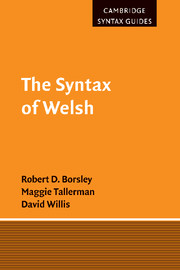1 - Introduction
Published online by Cambridge University Press: 01 October 2009
Summary
The Celtic background
Welsh is a member, along with Breton and Cornish, of the Brythonic subgroup of the Celtic branch of Indo-European. It is currently spoken by something over half a million speakers, mostly in Wales, but also by the Welsh community in the Chubut province of Argentina and by scattered pockets of speakers elsewhere, particularly in the major English cities.
The modern Celtic languages are descendants of the Common Celtic language once spoken in central Europe. By the first millennium BC, and probably for several millennia before, various Continental Celtic languages were spoken over large parts of western and central Europe. Gaulish in particular is well attested in a large corpus of inscriptions from the third century BC onwards, but there is also material in Hispano-Celtic, spoken in central eastern Spain, from the fifth century BC, and in Lepontic and Cisalpine Gaulish, spoken in northern Italy. Celtic migrations to the British Isles gave rise to the modern Insular Celtic languages. Of these, closely related Irish, Scots Gaelic and Manx form the Goidelic branch, and, somewhat less closely related Welsh, Cornish and Breton form the Brythonic branch. The Brythonic languages derive from the language spoken by the Britons across all of present-day England and Wales and much of southern Scotland before and during the Roman occupation. With the Anglo-Saxon migrations of the sixth and seventh centuries, speakers of the Brythonic (British) language were pushed west and north, and some migrated to Brittany, leading to the split of Brythonic into the separate languages that we see today.
The genetic relationship between the modern Celtic languages is exemplified in Table 1.1, which gives a selection of items that are cognate in all six of them.
- Type
- Chapter
- Information
- The Syntax of Welsh , pp. 1 - 31Publisher: Cambridge University PressPrint publication year: 2007

